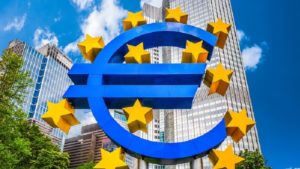The price of gold has been soaring, hitting a new high of $2,254 at the start of April. It has risen 23% over the past six months. While rate cut expectations partially explain the drop, they are not the full story, with a number of longer-term factors influencing the price. Should investors take a renewed interest in gold, or are they too late?
The immediate trigger for gold’s new highs was the latest round of US PCE inflation data. This showed the core PCE price index rising 2.8% year-on-year, low enough to keep a June interest rate rise on the table. Lower interest rates reduce the opportunity cost of holding gold, which doesn’t have a yield, and this sent the gold price higher.
See also: FE Fundinfo: March top 10 dominated by gold funds
However, a drop in treasury bond yields is only one factor driving the price. Juan Carlos Artigas, global head of research at the World Gold Council, also points to US dollar weakness, an increase in market volatility, and activity in the derivatives market for accelerating gold prices. Gold has been benefiting from a ‘flight to safety’ trade, as investors fret about US debt levels, but also from short-term factors, such as strong Chinese demand during the Spring Festival.
Fractious geopolitics
In the longer-term, geopolitical factors are also playing a significant role in the strength of gold. Steven Bell, chief economist, EMEA, at Columbia Threadneedle, says the gold price has behaved differently since Russia invaded Ukraine: “In my mind, that is due to the safe haven buying of gold. Russia foreign exchange reserves have been frozen. As the reserve mature, and a lot are short-dated, they go into an interest-free account, which Euroclear then puts on deposit. Europe has already decided that the interest income will go to rebuild Ukraine.
“In addition to the central bank, no less than 2,000 entities and wealthy individuals have been sanctioned. Their assets are frozen and they may well fear that the money will also be used to rebuild Ukraine post-war. 50,000 people round the world think it might happen to them. Gold is much easier to keep out of the long arm of Euroclear and the hands of the US Department of Justice.” Bell adds that the big spike in the last few weeks is more likely to be because the talk has become concrete in terms of the European Council using reserves to fund Ukraine.
There has been a central bank buying spree that has continued into 2024. The Financial Times reports that this has mopped up around $155bn of gold between September 2020 and December 2023, with another $229bn moving into gold bars and coins by private investors.
See also: Gold in the green: investors return to safe haven asset amid rising uncertainty
One notable weak spot has been Gold ETFs, with $46bn withdrawn since April 2022. Investors have noted that this has coincided with inflows into bitcoin ETFs and speculated that bitcoin may be picking up some of the ‘safe haven’ trade from gold. Bitcoin has seen a surge since the start of the year, that broadly matches the movement in the gold price. However, it is still highly volatile. A recent report by JP Morgan said that the move away from gold ETFs simply reflects a growing preference for bars and coins over exchange-traded options, with bitcoin’s popularity a separate factor.
Continued strength?
Some of the factors supporting the gold price remain in place. Neither US presidential candidate seems inclined to tackle burgeoning US government debt. The level of US debt is likely to exert continued pressure on the dollar, which may leave investors looking for ‘safe haven’ alternatives such as gold. The Ruffer Diversified Return fund, for example, holds gold as a hedge against inflation, believing that letting inflation run hot is “the most realistic long-term solution to bulging government deficits”.
Equally, geopolitical tensions are likely to remain in place. While there has been some thawing of US/China relations, trade barriers will stay. Sanctions against Russia and its allies are unlikely to be reversed with no signs of a resolution to the conflict in Ukraine. This could support central bank buying into the future.
Artigas says that upcoming expiries in options markets may bring additional investment flows if the gold price remains above key psychological levels such as $2,100/oz. He believes that this level has been a catalyst for traders to cover short option strategies and has driven further tactical investor interest.
However, the gold price remains vulnerable to expectations on interest rates. Artigas says a more hawkish stance by the Fed may create short-term headwinds for gold. Inflation readings have proved volatile, and the gold price has wobbled when markets have revised rate cut expectations.
Patrick Farrell, chief investment officer at Charles Stanley, is cautious, saying: “While geopolitical tensions remain high, the pressure points are well-understood and are likely to be factored into the gold price already. At the same time, gold prices tend to be inversely correlated with real (inflation-adjusted) yields. While inflation has been falling and interest rates not moving, real yields have been moving higher. They have started to drop a little since the start of November, but remain near their highest point since August 2020. This is a tough hurdle for gold to overcome and it looks vulnerable from here.”
There are a range of factors that govern the price of gold and it is difficult to predict which factor will drive the price at any given moment. Many asset allocators prefer to have a permanent allocation to gold to act as insurance against specific risks rather than trying to time entry and exit from the asset class.







